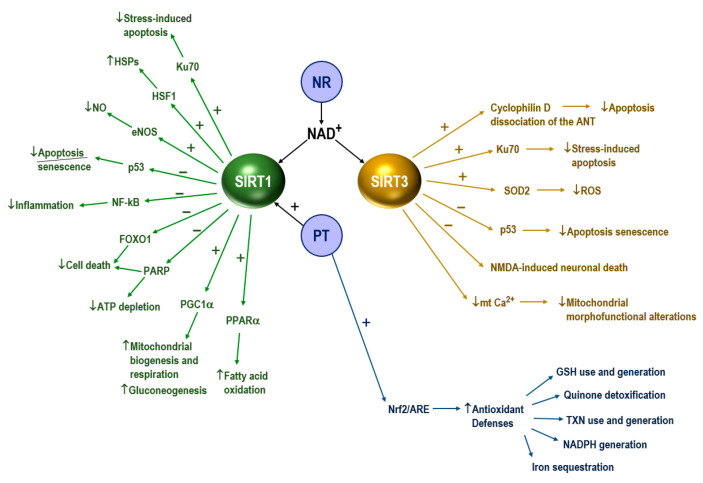Figure 1.
Molecular interactions underlying the effect of nicotinamide riboside (NR) and pterostilbene (PT) in amyotrophic lateral sclerosis (ALS). SIRT1, sirtuin 1; SIRT3, sirtuin 3; HSPs, heat-shock proteins; HSF1, heat-shock factor 1; NF-kB, nuclear factor kappa-light-chain-enhancer of activated B cells; FOXO1, forkhead box protein O1; PARP, poly (ADP-ribose) polymerase; PGC1α, peroxisome proliferator-activated receptor gamma coactivator 1-alpha; LXRs, liver X receptors; eNOS endothelial nitric oxide synthase; PPARα, peroxisome proliferator-activated receptors alpha; Nrf2/ARE, transcription factor Nrf2 (NF-E2-related factor 2)/antioxidant responsive element; ANT, adenine nucleotide translocator; SOD2, superoxide dismutase 2; NMDA, N-metil-D-aspartato; GSH, glutathione; TXN, thioredoxin. NR increases the availability of NAD+, which supports the activity of SIRT1 and SIRT3 and their downstream targets. PT activates SIRT1 and Nrf2. Activation of Nrf2 in MNs results in the induction of many cytoprotective proteins, i.e., (but are not limited to) the following: (1) GSH use and generation (γ-glutamyl-cysteine synthase, GSH reductase, xCT (a component of the cysteine/glutamate transporter), GSH peroxidase 2, different GSH transferase isoenzymes); (2) quinone detoxification (NAD(P)H dehydrogenase (quinone 1)); (3) thioredoxin use and generation (thioredoxin 1, peroxiredoxin 1, thioredoxin reductase 1); (4) iron sequestration (heme oxygenase 2); (5) NADPH generation (glucose-6-P dehydrogenase, phosphogluconate dehydrogenase, malic enzyme 1, isocitrate dehydrogenase 1) [42,65,73,74,75,76,77,78,79].

